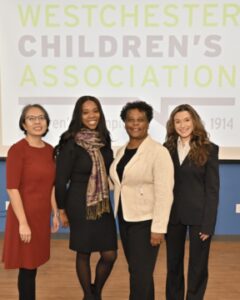
During last week’s Digital Inclusion event which took place during National Digital Inclusion Week, the Westchester Children’s Association (WCA) discussed the results of its survey on bridging the digital divide in Westchester County. The survey was conducted in partnership with Pace University and garnered more than 500 responses which are included in an analysis report titled, “Digital Access Survey: Perceptions of Parents in k-12 Schools in Westchester County, New York” by Sydney Moraitis, MPA Candidate, and Gina Scutelnicu-Todoran, Ph.D., Associate Professor of Pace University. One finding suggests 31 percent of the respondents reported that technology made their child’s learning more difficult.
Almost 25,000 households in Westchester County have no internet service according to the latest data from the US Census Bureau. Nearly 14 percent of people making $75,000 or less do not have an internet subscription. Those of Hispanic origin are almost twice as likely NOT to have an internet subscription than the rest of the population (2021 American Community Survey, Tables S2801 & S2802). For these economically fragile individuals, an online connection is a point of access to improved education, healthcare services, financial planning, and workforce development.
WCA and Pace University, along with the STEM Alliance and the Westchester Library Association (WLS), have formed the Digital Inclusion Coalition with the belief that digital equity is now a human right. “Our survey results have shown the problem; STEM Alliance and Raphael have highlighted possible solutions that work and the WLS and partners are leading the way in advocating for the county to take action and put $125,000 into the 2023 county budget to establish a leadership position, support the Coalition, plan a countywide digital equity summit and establish a portal to share information,” says Allison Lake, WCA Executive Director.
“Equity creates opportunity,” says Margaret Käufer, President of STEM Alliance. “With jobs in science, technology, engineering and math (STEM) expanding at an accelerated pace, there is high demand for skilled graduates and the STEM Alliance is creating a network of learning opportunities to help inspire and grow the next generation of STEM leaders. Our survey shows that 90 percent of our clients want to use their new devices to use and check email; 85 percent want to improve skills to get a better job; 80 percent would use their devices to look for a job online.”
“Our digital access survey recognizes that digital inequity is present in Westchester County in terms of student and family access to electronic devices, internet options, digital literacy, digital communication and experiences with remote learning,” says Sydney Moraitis, MPA Candidate at Pace University. “The survey’s findings suggest that digital access and literacy reform is necessary for all children and parents to be well-equipped to participate online and have confidence in doing so. It specifically identifies a need for digital literacy training for families of low socio-economic background and those of LatinX origin. I believe that conducting routine needs assessments for digital access and digital literacy should be encouraged to tailor services that provide for the specific and unique demographics of various Westchester County districts.”
Gina Scutelnicu Todoran, Associate Professor and Chair of Public Administration, Pace University agrees. “The fact that families and children from under-represented groups in Westchester County have fewer digital access opportunities than those who are better-off is not surprising. What’s new is that children and families from under-represented groups have different digital access needs. School districts and the NYSED should provide digital resources that are geared towards different constituent groups – whether it’s providing access to devices and internet, offering digital training, raising awareness about internet affordability programs, or ensuring multiple communication channels between educators, parents and students. Such an approach has the potential to narrow the digital divide gap.”






